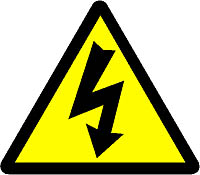Safety in the Shack
There are two safety considerations to bear in mind when setting up a radio shack – electrical safety and RF safety.
You will no doubt be using radio equipment that is mains powered, and you will probably use 12 V supplies that can supply up to 25 A or more. Mains electricity can kill you and that innocuous looking power supply could easily cause a fire if a short circuit occurs and you don’t have adequate safety precautions, such as a fuse.
Also, you will be producing radio frequency (RF) energy, which should be treated with respect.
Let’s deal with each of these in turn.
Electrical safety
 Firstly, every family member in your house should know how to turn the power off in your station. In the event of an emergency, and where you are still in contact with an electrically-live appliance, it could make the difference between life and death.
Firstly, every family member in your house should know how to turn the power off in your station. In the event of an emergency, and where you are still in contact with an electrically-live appliance, it could make the difference between life and death.
The wiring for your shack should ideally be controlled by one master switch and everyone in the house should know where it is. A fire extinguisher, suitable for use on electrical fires, is also a good investment.
All wires carrying power around your station should of the proper size and quality for the job. Also, all equipment should be connected to a good earth.
When working on equipment you should, if possible, ensure that it is switched off and unplugged. Any capacitors should be discharged as they can store charge for a considerable time.
If you must work on live equipment only do so if you know what you are doing. Also, keep one hand in your pocket at all times and all metal jewellery should also be removed. Avoid bodily contact with any earthed object to prevent you becoming the return path for any voltage source to ground.
If possible do not work on equipment when alone and always make sure that you have the correct tools for the job.
RF Safety
Radio Amateurs should be concerned about two aspects of RF safety when planning a station and its associated antennas.
Physical contact with antennas and parts of the station, which may be RF ‘hot’ and where there is a risk of RF burn or electric shock, must be a primary consideration.
This might include feeders to the antennas, or ungrounded metallic objects within the station or nearby.
Always arrange your antennas and feedlines so that they cannot be touched. This may mean re-routing them or putting them out of harm’s reach.
The second aspect is safety near the antennas in the so-called “near field”.
This the region where the distance from a radiating antenna is less than the wavelength of the radiated energy.
This implies that on the lower HF bands, say on 160 metres (Top Band), the near field could extend a considerable distance from the antenna.
However, in practice such an antenna would also be physically large, and would result in the incident power being widely distributed over a large area. For resonant dipoles there is a significant magnetic field near the feed, and a high E field near the antenna tips – both of these need to be considered as a safety consideration.
Every radio amateur should always ensure that persons in or near the station are not within the near-field safety zone recommendation of the antenna when transmitting.
But what is that zone? This is complex and you need to read the document “RF Safety and the Radio Amateur” mentioned above.
If you read nothing else, there is a rough rule of thumb.
For example, if you use a dipole, and 400 Watts, take the frequency in MHz, and use that spacing in feet (ft). That is, on 14 MHz a spacing of 14 ft is required as a safety distance. Or … If you use a beam with a gain of 9dB, and a transmit power of 100W, take the frequency in MHz, and use that spacing.
As you can see the higher you go in frequency the further you must keep away from transmitting antennas.
Other pages in this section – Setting up your shack:











